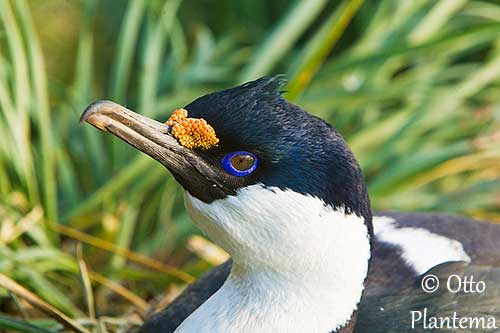
Fr: Cormoran géorgien
Ang: South Georgia Shag
All: Südgeorgienscharbe
Esp: Cormorán de Georgia
Ita: Cormorano della Giorgia australe
Nd: Zuid-Georgische Aalscholver
Sd: Sydgeorgisk skarv
Photographer:
Otto Plantema
Trips around the world
Text by Nicole Bouglouan
Sources:
HANDBOOK OF THE BIRDS OF THE WORLD vol 1 by Josep del Hoyo-Andrew Elliot-Jordi Sargatal - Lynx Edicions - ISBN: 8487334105
A Complete Guide to Antarctic Wildlife by Hadoram Shirihai and Illustrated by Brett Jarrett - Edited by Guy M. Kirwan - ALUL.A Press Oy, Finland - ISBN 9519894705
Wikipedia, the free encyclopaedia
Page family Phalacrocoracidae
Summary cards
South Georgia Shag
Leucocarbo georgianus
Suliformes Order – Phalacrocoracidae Family
INTRODUCTION:
The South Georgia Shag is a member of the “blue-eyed shag” group with pink legs and feet, placed in the genus Leucocarbo. This species was formerly a subspecies of the Imperial Shag.
DESCRIPTION OF THE BIRD:
Biometrics:
Length: 72-75 cm
Weight: 2,5-2,9 kg
The adult in breeding season has black-and-white plumage. The upperparts are black with bluish, violet and green sheen. Some birds may have a white restricted area on central back. The outer side of the thighs is black with blue gloss. Scapulars and upperwing have bronzy-green sheen. We can see a white bar formed by a variable amount of lesser wing-coverts. The tail is duller blackish with white shafts at base.
The underparts are white, including throat, head sides and neck sides. The underwing is blackish, with grey-brown sheen on greater coverts and flight feathers. There is a variable amount of white at base of the leading edge.
On the head, forehead, crown to just above the gap and nape are black. In breeding plumage, there is a black crest on the crown which is reduced or lost as the breeding period progresses. During this period, we can see some hair-like white filoplumes on head and upperparts. Two conspicuous yellow-orange warty caruncles are placed on both sides of the base of upper mandible, whereas the bare skin around the bill’s base and the gular pouch is blackish.
The bill is blackish-grey, variably paler at sides and with pale tip to lower mandible. The eyes are dark brown, surrounded by prominent blue eyering. Legs and webbed feet are pink with black claws.

Both sexes are similar, with male slightly larger than female. Outside the breeding season, they lack the crest. The bare facial area is duller with mostly greyer-bluish eyering. The caruncles are reduced. The white forewing patch is reduced or absent. The upperparts are duller.
The juvenile has mostly brown upperparts and white underparts. Crest and caruncles are absent. The bare facial skin is dull brownish with pale bill’s base and skin below the gape.
The immature has intermediate plumage between juvenile and adult, with blacker feathers.
RANGE:
The South Georgia Shag is restricted to South Georgia, South Orkney and South Sandwich, and Shag Rocks in the Scotia Sea.
HABITAT:
The South Georgia Shag breeds on grassy slopes on islets and rocky areas, or on cliff ledges and stacks. Some nests can be made on flat or gently sloping ground with tussock grass. It feeds inshore.
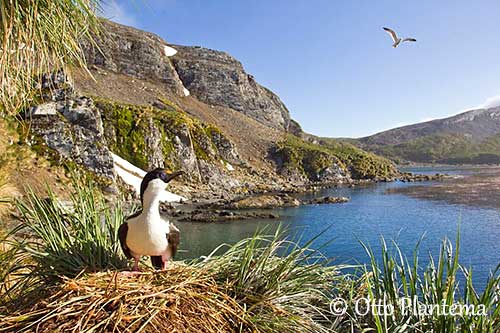
CALLS AND SONGS:
The South Georgia Shag gives various barking and moaning calls, whereas the female hisses. They are usually silent outside the breeding season.
BEHAVIOUR IN THE WILD:
The South Georgia Shag feeds primarily on fish caught by pursuit-diving. The male usually dives deeper than the female, thanks to its larger size, and male and female forage at different times of the day. This species often feeds alone or in small flocks. They can take fish of up to 25-27 centimetres long. They also take molluscs (octopods and bivalves), and polychaetes (annelids).
The South Georgia Shag is monogamous, but the pair-bonds are only for one season. They can nest solitary or in small colonies, but sometimes larger and dense colonies too.
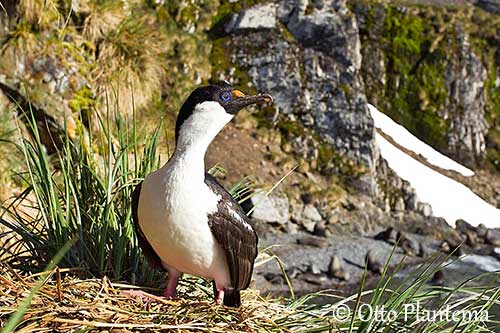
During the courtship displays, the brightly coloured bare facial parts are enhanced by some ritualized postures. The bill is pointed upwards and forwards to expose the coloured pattern. The white patches of wings and back are also enhanced by “wing-waving”.
The South Georgia Shag is sedentary. Only short-distances movements are observed towards ice-free waters during the austral winter.
Like other cormorants and shags, it usually flies low over the sea surface and at greater heights over land. The flight is powerful with regular, continuous wingbeats.
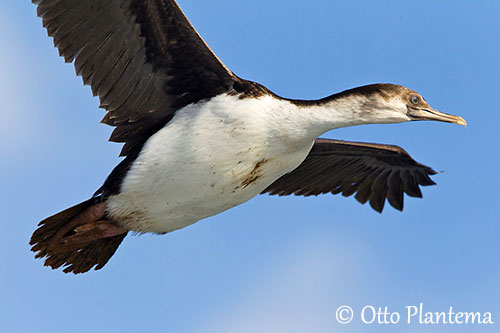
REPRODUCTION OF THIS SPECIES:
The breeding season occurs in October/December.
The South Georgia Shag usually breeds in small colonies or solitary. It builds a nest with seaweed, grass, mud and excreta. It is a truncated cone placed on grassy slope. Some nests can be made of penguin tail feathers and placed on the ground.
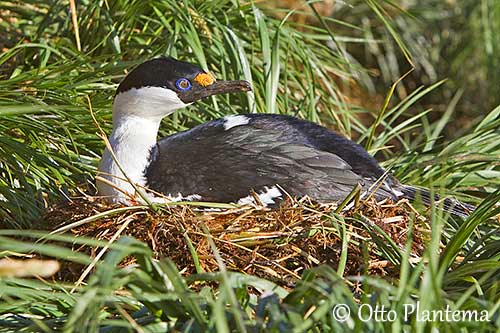
The female lays 2-3 greyish to bluish eggs in November/December. Both adults share the incubation during about one month (28-31 days). At hatching, the chicks are naked, and they are continuously brooded for 12-15 days. Then, a dark grey down grows quickly. Both parents feed them at nest. They fledge between 56 and 65 days after hatching. They are sexually mature at three years old.
PROTECTION / THREATS / STATUS:
The South Georgia Shag is not globally threatened, with a fluctuant population estimated at about 7500/11,000 pairs. The species is currently evaluated as relatively stable in spite of some decline. But more information is needed.